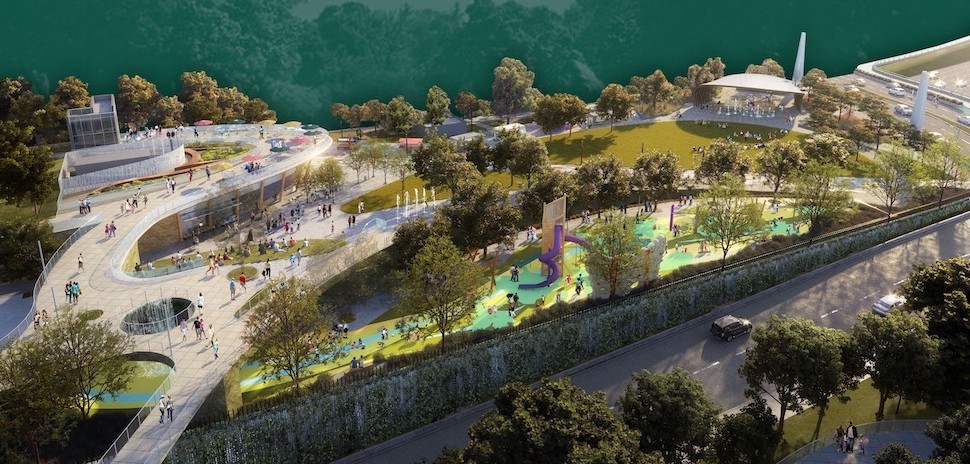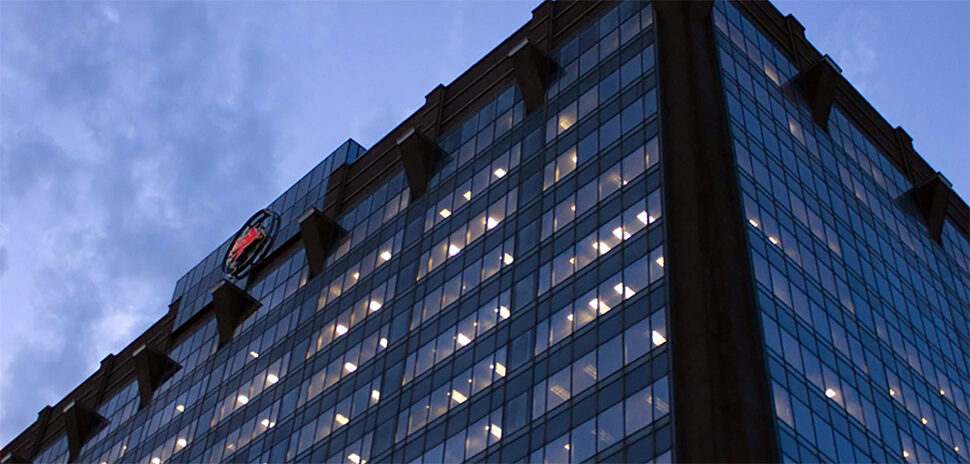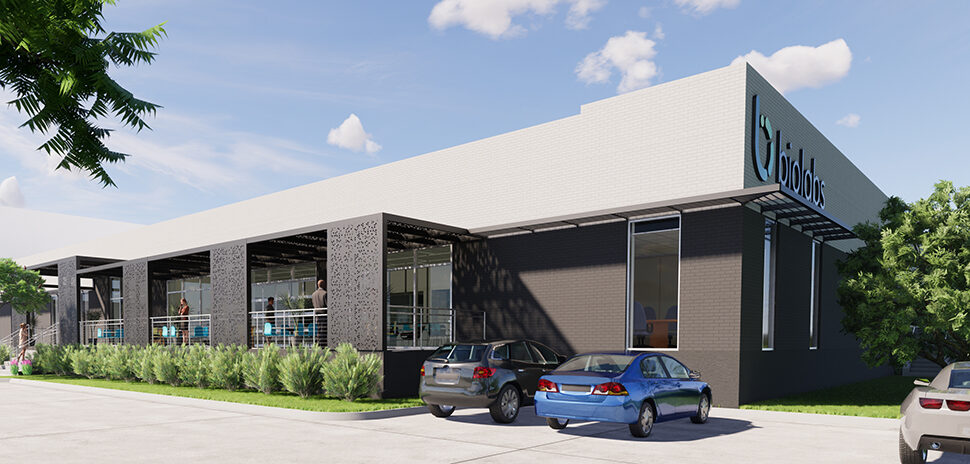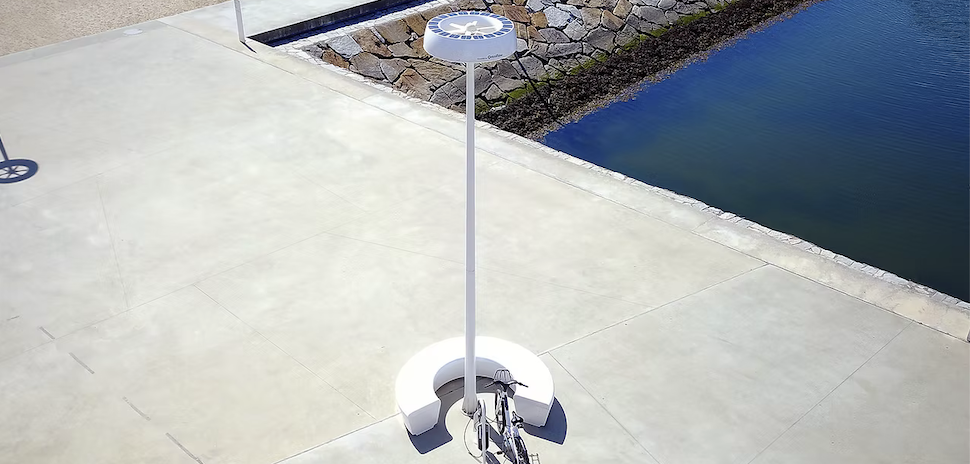If you think Dallas’ Klyde Warren Park is amazing—the green space over Woodall Rodgers Freeway has drawn crowds since 2012—a new park four miles to the south will truly deck you. Pillars are now being poured and support beams are climbing skyward for an even more phenomenal engineering achievement—Southern Gateway Park.
“It’s not an idea—it’s happening,” says April Allen, president of the Southern Gateway Public Green Foundation.
Phase One of the $172 million, five-acre deck park is slated to open in late 2023, stretching from Ewing Avenue to Lancaster Avenue. Phase two will lengthen the park southward to Marsalis Avenue. The Dallas Zoo is planning its own 7-acre adjacent park that would ultimately create a sprawling, 12-acre signature attraction for the city of Dallas.
Dallas City Council approves development agreement
Two weeks ago, the Dallas City Council unanimously approved a development agreement for the deck park with the Southern Gateway Public Green Foundation.
Phase One of the deck park is projected to cost $82 million. The North Central Texas Council of Governments’ Regional Transportation Council approved $40 million for the project; the city of Dallas committed $7 million from a 2017 bond program; and just last week, the U.S. Department of Transportation awarded $900,000 for the project. The Southern Gateway Public Green Foundation is raising the rest from private donors.
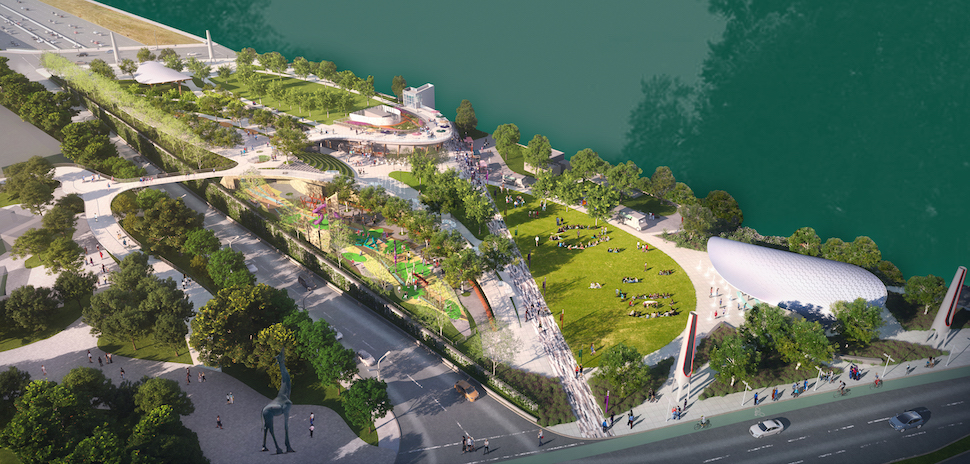
Southern Gateway Park’s Phase One (right side above, including the hilltop-covered restaurant/retail complex at center) and Phase Two (upper left above). [Image: HKS]
Deck park will “weave” Oak Cliff back together
In the 1950s, the construction of I-35E cut Oak Cliff in two, isolating the Tenth Street Historic District on the east side of the highway for generations. One big mission of Southern Gateway Park is bridging that gap and healing that divide—by bringing the neighborhoods together once again.
April Allen calls it a “park with a purpose” with a goal to “weave the community back together, and build a bridge to a more prosperous future for that community.”
Yavar Saremi, an architect working on the park for Dallas-based HKS, notes that “immediately to the west of the park we have Dallas’s largest Latino community in the Jefferson Boulevard area. So we really thought about this park as the common ground and area of cultural confluence of this diverse neighborhood of Oak Cliff, to really come together after this long history of being divided by the highway infrastructure.”

April Allen, president of the Southern Gateway Public Green Foundation [Photo: SGPGF]
‘Announcing your arrival to the city of Dallas’
Allen believes the deck park will literally be a gateway—announcing to millions of drivers flowing northward on I-35E that they’re arriving in the city of Dallas.
But she sees it as a figurative gateway, too.
“When the freeway came through—coupled with inequitable housing policy, education policies, and transportation policy—the communities around the park have felt the effects of that inequity to this day,” Allen told Dallas Innovates. “The park can be a gateway to closing those opportunity gaps, as we spur the type of economic mobility and cultural revitalization that’s needed.”
A gateway to a connected community for all
“I’m a resident of Oak Cliff,” Allen said. “In Oak Cliff, we’re really proud of the way that we live in a very interconnected way across racial lines, socioeconomic lines. We can demonstrate that to the rest of Dallas at this park and really be a test case for how we use infrastructure investment like this to build community.”

Yavar Saremi of HKS, project architect for Southern Gateway Park [Photo: HKS]
The community asked, and civic leaders responded
Both Allen and Saremi say a key driver of the deck park’s creation was the community surrounding it, after TxDOT announced plans to widen I-35E between I-20 and I-30 as part of its $666 million Southern Gateway Project,
“We had the success of [Klyde Warren Park] downtown and there was a recognition that it could drive the type of growth that we need in our communities,” Allen said. “When there was talk about the big Southern Gateway project, it was like, ‘Hey, while you’re here, can you also give us that type of signature space as well?’ The community came together to really advocate for the idea.”
HKS’ Saremi told us that community involvement was also key “from the get-go” in planning the park’s features.
“We kept hearing from the community that they really wanted something they could be proud of, so they could really feel a sense of ownership,” Saremi told us. “Something that can represent Oak Cliff to the rest of Dallas and to the North Texas region at large.”
“We held many meetings,” he added. “We collected more than 300 comments. We were having bilingual meetings over Zoom. We were reaching out to local leaders to make sure that they get the word out. The park design as it stands now is a true reflection of what we heard in those meetings.”
Allen says the outcome has been a huge hit.
“HKS and Yavar beautifully translated that input into this design that we’re just thrilled about,” she said. “We hear from our community that they couldn’t be more excited.”
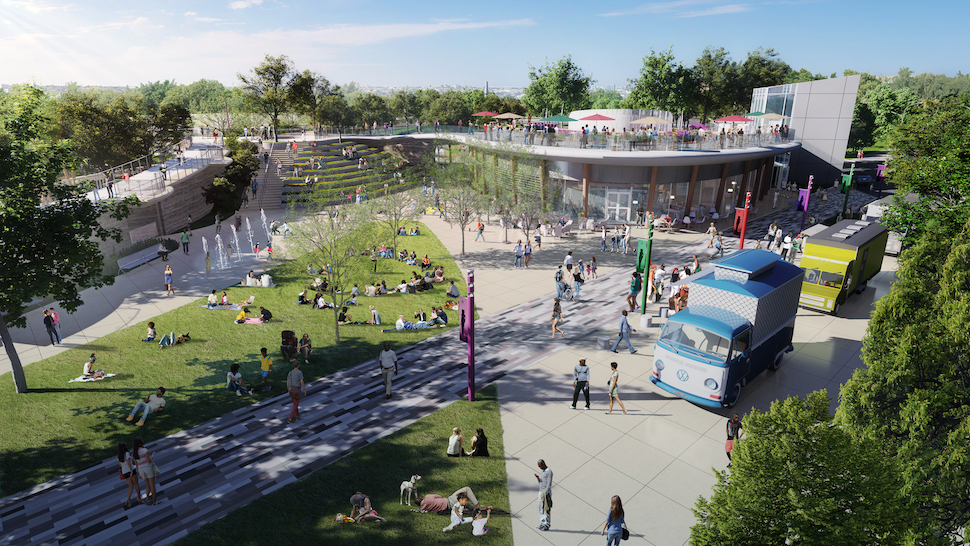
Gateway Park will be like Oak Cliff itself—anything but flat. A restaurant/retail complex (top right) will exist beneath a long, sloping, wooded lawn. An area for food trucks will nestle along the promenade, which will feature historic markers. [Image: HKS]
Reflecting the natural topography of Oak Cliff
One thing the community wanted was for the park to be true to Oak Cliff’s hilly, rolling beauty. Saremi saw the chance to create a “gateway” from the prairie to the hill country.
“It’s very flat north of the Trinity River,” Saremi said. “As soon as you drive into Oak Cliff you’re seeing escarpments, you’re seeing topography. We thought that could be one of the ways where we make this park really of its place.”
So, unlike Klyde Warren Park—which aside from a few small berms is very flat—Southern Gateway Park will have lengthy slopes, escarpments hewn out of natural rock, and wooded walkways high and low. That requires a lot of landscaping, so HKS is working on the project with the SWA Group and its landscape architect, Chuck McDaniel.
The Phase One north end of the park will feature a stage pavilion and 15,000-square-foot lawn for performance events, with a playground running down the eastern edge of the park toward the south, where it will extend into Phase Two.
A restaurant/retail complex will be at the park’s center, denoting the southward end of Phase One. To make the complex seem less like a “building,” the long, sloping lawn from Phase Two will extend upward and over it, offering dramatic views in all directions.
Great views wherever you look
Saremi says the HKS team was very conscious of creating striking views—and offering “different arrival experiences” as you enter the park from different directions.
Entering from the north side of the park along Ewing Boulevard, visitors will walk past two tall, vertical iconic elements. (“You’ll see them from the highway driving south and through the neighborhoods,” Saremi says. “They’ll be great visual markers for where the park is and really orient the patrons to the park.”) Next, visitors will see the pavilion stage structure, which acts as a gateway to the expansive viewing lawn.
“Coming in from the zoo side, you really arrive at this zeitgeist moment at the park, where as soon as you arrive you have great views to the playground, to the amphitheater immediately near the landing area, and views of the main lawn and pavilion stage as well,” Saremi said.
“And from there, you can take the ramp up to the City View Terrace, which we’re creating as an open plaza with views—great views of the park, but also great views of the Dallas skyline,” he added.
A ‘natural’ playground with an ‘in-the-woods’ feel
When the Phase One and Phase Two playgrounds are completed and linked up, they’ll cover 15,000 square feet and be unlike most any other playground in North Texas.
“We’re really playing up the natural aspects of this park in the playground,” Saremi said. “A lot of the playing equipment that we’re looking at has a natural, playground-in-the woods feel. We hope that that really ties in well with the area and what’s happening at the zoo.”
From the playground, a large, cascading ramp will lead up to the zoo bridge connection, and also connect visitors to the top of the amphitheater.
“A lot of the topography will be expressed through the cascade and the bridges,” Saremi said. “We’re working with some local manufacturers to recreate some kind of escarpment rock formation in an abstract way, to really tie that back into the geology of Oak Cliff.”
Healthy food options within a flexible space
Inside the half-hidden restaurant/retail complex, there will be healthy food options requested by the community, and something more: opportunity.
“We wanted to be really intentional about keeping it flexible so that we could invite area business owners in,” Allen said. “It has leasable space that won’t be out of reach in terms of lease expense, and have a tenant mix in that space that reflects Oak Cliff.”
“History stairs” and plaques rekindle a storied past
The plaza by the restaurant/retail complex will be the active heart of the park—featuring “history steps,” an amphitheater for neighborhood schools and public use, and an escarpment wall that overlooks the area, featuring art and stories about Oak Cliff’s storied past. Fountains and water features are sure to be magnets for squealing, delighted kids.
12th Street Promenade will ‘re-stitch’ a historic pathway
A “12th Street Promenade” threading through the park—also known as La Calle Doce—will be a pedestrian version of what 12th Street was here long ago, physically connecting the northwestern side of Oak Cliff to the 10th Street Historic District.
“That is actually one of the biggest organizing elements through the park—re-stitching and rebuilding that lost connection that we once had in the neighborhood,” Saremi said.
Metal plates embedded in the promenade will honor notable citizens of Oak Cliff through the ages. The history built into the promenade will be “an interactive educational experience as people walk on this path that was demolished and is now rebuilt back,” Saremi said.
As the promenade passes the restaurant/retail complex, an area will be provided for food trucks—another community “ask.”

Southern Gateway Park Masterplan [Image: HKS]
Phase Two will be less formal, more green, with key features
To mirror the transformation in Dallas’ north-south topography, as you move southward into Phase 2 of the deck park, you’ll have a greater sense of sloping topography—less formal and more green—with the restaurant/retail complex acting as a kind of peak looming above it toward the north.
The extension of the playground into Phase Two will be accompanied by “a lot of areas for reflection and healing,” Saremi said. “There is the Prairie Garden, which would be more of a quiet area for reflection for relaxation.”
At the southeastern corner of Phase Two, a second pavilion will provide an area for a flea market or farmers’ market.
“The idea of community gardens also came out as we talked to some people involved with the 10th Street Community Garden that is actually very close to the site,” Saremi said. “Every time they give out produce there are huge lines, and they said it would be great if they have an area to sell the products or bring it up to the community.”
To ease gentrification concerns, a diverse housing plan
Some have raised concerns that a $172 million park could lead to gentrification and displacement of lower-income people in the area. Allen’s foundation is striving to find a balance between revitalization and gentrification, to ensure the community benefits from the park without losing its identity.
“We did a year-long equitable development planning process which resulted in an equity plan,” Allen told us. “One of the pillars of that plan is diverse housing options. We engaged with 500 community members throughout that year-long process around multiple questions, one of them being diverse housing options.”
The foundation views itself as “a convener of stakeholders and an advocate for diverse housing.”
“We want there to be a mix of workforce housing, market rate, and senior living,” Allen explained. “I think our communities are better when they have a diverse mix. We’ve also worked with our local public policy leaders around ideas like property tax abatement overlays. That’s an idea that our mayor actually had when he was in the legislature. And our local state representative proposed legislation last session around that, as well as other legislators in the Dallas delegation.”
“Those types of policy tools are things that as a foundation we want to continue to advocate for, so we can mitigate some of those unintended consequences.”
A ‘big, big deal’ for the future of Dallas
Allen believes that once Southern Gateway Park is built and attracting visitors in droves, it won’t just be great for Oak Cliff—it’ll be great for Dallas as a city, as it works to heal the past and embrace a more connected future.
“There are limited areas in Dallas to grow,” Allen said. “We’re adjacent to this jewel of Dallas in the Dallas zoo that draws over a million visitors a year. Some of the pioneers that started the city of Dallas started in Oak Cliff. Lake Cliff Park used to be the center of recreation with a big amusement park.”
“It’s kind of neat to be bringing all of that history back full circle with the park project, in a way that really moves our city forward on multiple fronts—moves it forward culturally, moves it forward economically, moves the dialogue forward in terms of the whole north-south divide.”
“All of those stakeholders coming together to make something this significant happen in Southern Dallas is a big, big deal,” she added. “I think overall it’s a positive sign and a real reason for us to be optimistic about the future of our city and what it prioritizes.”
![]()
Get on the list.
Dallas Innovates, every day.
Sign up to keep your eye on what’s new and next in Dallas-Fort Worth, every day.

